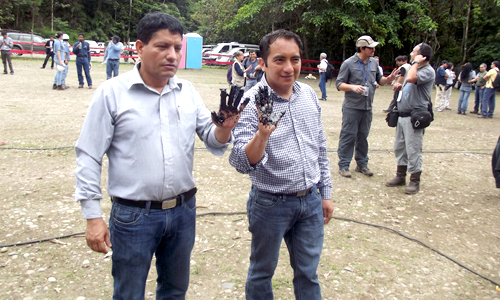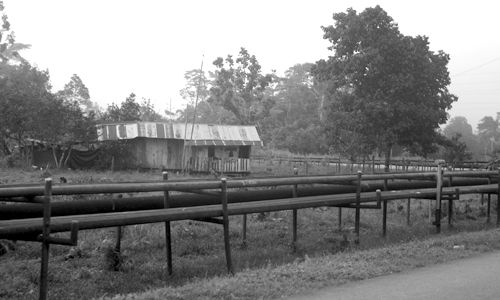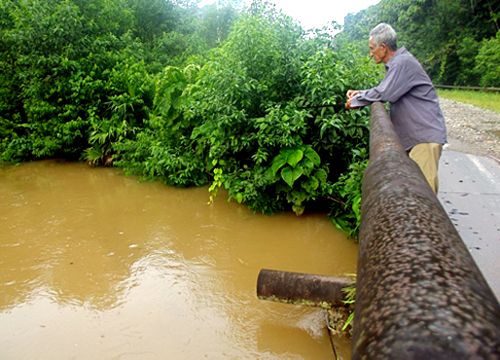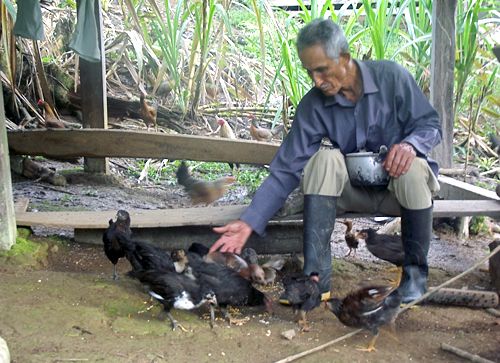

By Adam Chimienti
“This is the Court of Chancery … which gives to monied might the means abundantly of wearying out the right, which so exhausts finances, patience, courage, hope, so overthrows the brain and breaks the heart …” — Charles Dickens, Bleak House
The court proceedings in the case of the 21st century, between multinational oil giant Chevron and the Ecuadorian Amazon communities affected by oil contamination, are reminiscent of the muddled legal saga around which Dickens’ Bleak House is centered. As with the parties in the 1853 novel, the plaintiffs have been denied justice over the course of many years. Their plight will continue into 2014.
Of course, this could’ve been the year when one of the world’s most profitable corporations realized that it was no longer worth dragging its feet and finally figured out a way to rectify the damage that Texaco (acquired by Chevron in 2001) committed while exploiting the major oil reserves in the country beginning in the late 1960s.
This could’ve been the year when U.S. judges rebuked Chevron and discouraged any further attempt to deny the damage the company is responsible for.
This was the year when Ecuador’s Supreme Court reduced the judgment back to the original amount of $9.5 billion, less the punitive damages applied after Chevron refused to apologize.
This was also the year when proceedings in other countries took some interesting turns, like the recent decision in the Ontario Court of Appeal, lifting the hopes of the affected populations. This latest ruling, which overturned an earlier decision that Chevron Canada’s assets are not directly owned by the U.S. corporation, will likely result in the case being brought before the Supreme Court of Canada.
Chevron relies on armies of lawyers and its allies in the press to confound the issues. Yet, in this peculiar case, there is so much more than meets the eye. For example, Chevron has capitalized on the Ecuadorian government’s hypocrisy when it comes to environmental matters. In 2013, it became increasingly evident that the progressive environmental language in the 2008 constitution is not nearly as essential as the extractive agenda of President Rafael Correa’s administration.
This 21st century struggle reveals what is and what is no longer possible in the battle over resources and life, between the excessively wealthy and their victims.
Here are eight essential elements of the case you should understand.
1. The History of Texaco in Ecuador
Texaco was first invited to Chevron in the early 1960s and began exploring for oil in 1964 in the Lago Agrio region of northeastern Ecuador. During roughly two decades of extraction and major profits, a consortium initially consisting of Texaco and Gulf Oil, with a 25 percent share later acquired by the Ecuadorian state oil company, CEPE (now Petroecuador) built a pipeline to carry crude across the Andes for export. Texaco, which was widely regarded as a world leader in the oil business, did not use costly techniques such as re-injecting wastewater underground. Instead, much of its waste was pumped into unlined pits and crude oil was poured everywhere, including the streets of Lago Agrio.
In the late 1980s, several earthquakes would cause extensive damage to the pipeline and lead to organizing efforts by indigenous groups and environmental activists. Those living near the oil-drenched forests were emboldened by support they received throughout the country and around the world.
These complex networks developed quickly and in November 1993, shortly after Texaco departed the South American nation, affected Ecuadorian citizens began to seek legal action in New York. That first lawsuit was eventually thrown out due to jurisdictional matters. Despite complaints by the plaintiffs that Ecuador’s courts were ill equipped to handle such a case, Texaco, then acquired by Chevron in 2001, was happy to have the case moved to Ecuador and praised the court system there in a series of affidavits. The New York court required that the oil giant submit to the jurisdiction and judgment of the Ecuadorian court, although many argue Chevron believed it would be successful in controlling the outcome there.
2. The Record Judgment
The new case Aguinda vs. Chevron began in May of 2003 and ended Feb. 14, 2011, when the Lago Agrio court found Chevron guilty of the contamination and required an apology. The $8.6 billion for an environmental remediation and services to address the various needs of the communities, based largely on a 1999 study by the Spanish doctor Miguel San Sebastian, doubled to more than $18 billion after the company failed to apologize, and later increased to $19 billion in July 2012.
Chevron has repeatedly stated that the plaintiffs will never receive a dime of the company’s vast assets, estimated at around $244 billion. The firm has spent significant sums of money fighting the judgment it believes is fraudulent, asserting that the state oil company is responsible for the remaining pollution in the forest.
Most recently, the judgment has been cut in half to $9.5 billion by the Ecuadorian Supreme Court. Meanwhile, the Lago Agrio judge who passed down the verdict in 2011, Nicolas Zambrano, has been depicted as corrupt for allowing the verdict to be ghostwritten in return for an alleged $500,000 kickback from Donziger’s legal team. Chevron’s star witness Alberto Guerra, the former judge who presided over the case and now claims he helped negotiate the bribery scheme involving Zambrano, corroborated this claim. Hardly credible himself, Guerra has admitted to extensive bribery schemes in the past and is now openly being paid by Chevron to live in the U.S. with “$10,000 a month in living expenses, a $2,000 monthly housing allowance, health insurance coverage for himself and family members, a leased automobile, payment for an independent attorney, payment for an immigration attorney and moving expenses.”
3. The Legal Proceedings
There are now six cases in as many countries and on three different continents.
- The original Aguinda vs. Chevron case recently made its way before the Ecuadorian Supreme Court where the judge removed the punitive damages, cutting the judgment by half. Chevron has no assets in the country and therefore the plaintiffs are forced to look elsewhere to seize company property to sell.
- The first attempt to seek assets abroad was in the Ontario Superior Court in Canada. In early May of this year, a Canadian judge found that the subsidiary, Chevron Canada, could not be subject to the Ecuadorian ruling. However, a three-judge panel in the Ontario Court of Appeal overturned the decision in December. Justice James MacPherson drew attention to the confidence of Chevron, referring to a comment about the company’s willingness to “fight this until hell freezes over” and then “fight it out on the ice.” The Canadian judge then wrote, “Chevron’s wish is granted. After all these years, the Ecuadorian plaintiffs deserve to have the recognition and enforcement of the Ecuadorian judgment heard on the merits in the appropriate jurisdiction. At this juncture, Ontario is that jurisdiction.”
- The Argentine Supreme Court also weighed in on the matter, overturning a lower court’s decision to freeze Chevron Argentina’s assets there, thereby clearing the way for a major shale oil investment by Chevron. Plaintiffs have indicated they would appeal this ruling.
- Brazil’s Superior Tribunal of Justice is also considering the case, although Chevron’s extensive production there (33,000 bpd of crude) is a factor.
- Chevron vs. Donziger et al, is a racketeering or RICO case that was heard from Oct. 15 through late November in the Southern District of New York. Steven Donziger, the lead adviser to the Ecuadorian plaintiffs in Aguinda-turned defendant, unsuccessfully attempted to get Kaplan removed for bias and now the U.S. judge is set to deliver his verdict in early 2014. This case has already featured remarkably broad subpoenas including access to email data from firms such as Google, Microsoft and Yahoo!, 600 hours of video footage from an award-winning documentary, and a failed attempt to acquire environmental NGO Amazon Watch’s internal documents and testimony. Donziger’s legal team will likely appeal the unfavorable verdict they expect to the U.S. Court of Appeals for the Second Circuit.
- Finally, the Permanent Court of Arbitration at the Hague is hearing Chevron vs. Ecuador to determine whether Ecuador’s government should have intervened to stop the Aguinda trial from proceeding due to a Bilateral Investment Treaty (BIT) signed with the U.S. in the 1990s. The Ecuadorian government points out that the treaty was signed in 1993, went into effect in 1997 and can not retroactively apply to the damages caused by Texaco when they left the country in 1992.
There may soon be additional litigation before courts in Colombia, Panama and Venezuela.
4. The Lawyers
Steven Donziger has been the lead adviser for the plaintiffs since the first trial in New York against Texaco. The Manhattan attorney, once a basketball cohort of President Obama, is depicted as having an ego that may be too big for his own good. He is often the most high profile name directly involved in the case, serving as a lightning for Chevron and its supporters in the financial press. Paul Barrett, a chief reporter for Bloomberg Businessweek, who recently finished up a book on the trial, also finds Donziger a colorful character through which to explain this case. Unfortunately, this focus ignores many of those whose lives have been deeply affected.
It appears much more difficult for Chevron to malign the name of the lead attorney for the plaintiffs, Pablo Fajardo. Along with his Ecuadorian colleague Luis Yanza, Fajardo won the Goldman Environmental Prize in 2008 and he was the CNN “Hero of the Year” in 2007. Both Fajardo and Yanza hail from the Oriente and have spent much of their lives in communities that have been affected by irresponsible oil drilling practices.
Meanwhile, Patton Boggs, a prominent U.S. law and lobbying firm, joined the plaintiffs’ legal team in early 2010. They immediately began planning the best way to effect a settlement but that seems unlikely. In fact, the battle has only become nastier as Gibson Dunn, Chevron’s LA-based firm retained in 2009, has portrayed Patton Boggs and the entire Ecuadorian legal team as guilty of defrauding Chevron. One legal ethics expert pointed out that, “Patton Boggs is a firm of recognized standing. This is accusing them of fraud, and that’s going to be bitterly fought.”
5. The Media and the Documentarian
Donziger also worked to attract allies through media outlets. His strategy was to land favorable coverage in major news outlets such as BBC Newsnight, 60 Minutes and others. In 2007, the Vanity Fair’s annual “Green Issue” featured a lengthy piece about the case attracted celebrities and other moneyed interests to the cause. Some notable entertainers, such as Sting and his wife Trudie Styler, have remained involved and continue working on related environmental issues in Ecuador.
However, this strategy backfired somewhat when the 2009 documentary Crude, directed by Joe Berlinger, produced unintended consequences. Throughout much of the footage and in the final film, Donziger was again a focus and the attorney had a bad habit of embarrassing, if not potentially incriminating, himself on camera. In one troubling scene, the international NGO Amazon Watch’s founder Atossa Soltani responds to a plan by Donziger to assemble an “army” (Soltani points out that this is an especially troubling term in military coup-plagued Ecuador) of protesters. She asks about the likelihood of Berlinger’s video footage being subpoenaed saying “I just want you to know it’s illegal to conspire to break the law.” Donziger more or less dismissed her concerns about possible subpoenas, yet within months, Chevron had obtained the footage and their own high-priced army of lawyers set about examining and distributing it.
[youtube //www.youtube.com/embed/duFXuRnd2CU expand=1]
Well-versed in public relations itself, Chevron created its own views and opinions website devoted to the case, which served as a blog/aggregate for news reports and right-wing commentary. Forbes (where Donziger himself was published), The Wall Street Journal, Bloomberg Businessweek, Fortune (CNN), and other publications that followed the case tended toward Chevron’s side of the story, while other major news outlets like The New York Times, Washington Post and San Francisco Chronicle are more nuanced in their approach.
6. The Governments
One of Chevron’s main contentions is that Texaco’s agreement to remediate its share of concessions with the Ecuadorian government in the mid-1990s exonerates the multinational from any environmental damages. These arrangements took place under President Sixto Duran Ballen, a dual U.S./Ecuadorian citizen who had been advancing neoliberal reforms begun in the previous decade. Many Ecuadorian observers close to the case believe the Duran Ballen government’s numerous corruption indictments effectively nullified the remediation and note that Chevron was released before remediating a single site. Furthermore, as many critics of neoliberalism have pointed out, the Washington Consensus and the conditional assistance programs from International Financial Institutions (IFIs) came about as a result of coercion and corruption often involving the U.S. and other Western governments.
In the early 1970s, Henry Kissinger, fresh from his role in “making the Chilean economy scream”, was personally involved in negotiations and disputes between the Texaco consortium and the government in Quito. At that time, the military regime in power depicted itself as revolutionary and nationalist, promising progressive policies. Coinciding with a shift to markedly increased dependence on the oil sector, oil prices began an upward climb that would last into the early 1980s. Since Ecuador was one of the newest and smallest members of OPEC at the time, it perceived a hostile approach on the part of the U.S. government and feared it was going to be made an example of for other countries.
Three decades later, a lobbyist for Chevron would argue that “We can’t let little countries screw around with big companies like this-companies that have made big investments around the world.” A la Dickens, this corporate mentality obscures the more compelling realities of this case.
7. The Scientists
In early 2013, Chevron claimed a victory when the Colorado-based scientific consulting firm Stratus withdrew their support for the plaintiffs. The environmental experts disavowed the environmental damages assessment conducted by Richard Cabrera. In his role as an independent court-appointed expert, Cabrera was reportedly in close contact with the plaintiffs and their allies at Stratus and this was corroborated by videos subpoenaed from Berlinger. Cabrera’s report, allegedly ghostwritten by the plaintiff’s allies, is portrayed as lacking in requisite scientific credibility.
Considering the immense destruction of Amazonian habitat, such an assessment may not even be possible. Kelly Swing, a professor working via Boston University in a research station in Yasuni National Park, offered among the most poignant explanations I have heard regarding oil contamination in northeastern Ecuador. Swing explained to me that this region is among the most biodiverse, or megadiverse, in the world. This is due to the Andean-Amazon corridor (with it’s abundance of fresh water) as well as the proximity to the equator.
Look at a map however, and you’ll quickly notice that the section of Yasuni where Dr. Swing and others are doing their research is well over 100 kilometers south of the equator, meaning that the richest biodiversity in Ecuador (and the world) was likely in the same region that was first reached by missionaries and then oil companies. “We may have already lost the pinnacle of species [near Lago Agrio] without even noticing,” Dr. Swing lamented.
Confounding the situation, the government in Quito announced this summer that it has no choice but to move ahead with oil exploration in Yasuni, sparking widespread protests from students, environmentalists and indigenous organizations. Under the Correa Administration, poverty has declined significantly as a result of increased social spending. However, in exchange for what amounts to under two weeks worth of global oil usage in Yasuni’s reserves, many more hectares of Ecuador’s remaining virgin rainforests will be compromised if the government proceeds with its ambitious extractive agenda.
8. The Affected Population
At a press conference in the Amazon in September, Ecuadorian President Rafael Correa, held up an oil-soaked hand and addressed the camera as if there were Chevron executives directly behind it:
“I believe that this is an exemplary case, not only of the injustice but of the immorality of the world order, world institutions, where everything is on the side of capital, where there is a total supremacy of capital, of multinationals over people, over societies, over nations, and this inspires us and drives us and helps us to see much more clearly the mission to reform this world order as much as possible to be on the side of justice.”
While this sounds impressive, many of the affected in the Lago Agrio region direct their complaints at state-owned firms Petroecuador and Petroamazonas. Several farmers in the region explain that water is the most critical issue facing the people of the Lago Agrio region. Many believe that the government isn’t seriously addressing the contamination despite the government’s own irresponsible practices.
A question remains: Is the Correa administration, celebrated as progressive around the world, simply another government that puts the rights of indigenous peoples and the environment after the needs for capital and investment? Many activists here would say yes.
While the Ecuadorian government now appears ready to use its resources to join in the plaintiffs’ struggle, its critics can’t help but notice that these efforts come on the heels of the controversial decision to move forward on exploiting the oil blocks in the Yasuni-ITT region. It is likely that the government will have considerable difficulty maintaining the guarantee that state oil companies or their foreign partners can avoid causing similar damage to the people and habitats of the rainforest. Factored alongside various other environmentally destructive megaprojects being planned or carried out to advance development, such political moves and cynical attitudes are to be expected.
Moving Forward
Ecuador, like many other developing countries, is in a difficult position regarding its own future. Its government, despite the revolutionary rhetoric and unorthodox views of its leftist president, is mired in the paradigm of extracting and exporting natural resources with all its attendant problems. Texaco, in its decision-making several decades back set the stage here for a long, drawn-out tragedy. An increasing dependency on fossil fuels, will wreak further damage that cannot be quantified nor qualified. Genuine remediation is a rather difficult goal to achieve.
In a visit to New York in September, Ecuador’s Minister of Minister of Foreign Affairs Ricardo Patino recently argued that ChevronTexaco is responsible for the destruction of the vast swaths of rainforest and diseases and deaths of many Ecuadorians. These are serious charges. Chevron will continue to convey the message that this is all a scheme by Ecuador to extort funds from its famously deep pockets. These statements demonstrate for posterity how legal battles over environmental destruction fall far short of responsible action and how complex arrangements within the highly centralized corporate/nation-state structures plague the periphery.
Today, debates about fracking, tar sands, exploiting oil in extreme locations such as the Arctic and the future of nuclear energy are unavoidable. The enduring lesson from the willful destruction of the Ecuadorian Amazon will prove to be more about a system of capital, extraction and laws that is thoroughly flawed and broken. It is clear that the system is currently incapable of remediating the destruction it makes. Just what would Dickens make of this bleak 21st century story?

 233k
233k  41k
41k  Subscribe
Subscribe 





